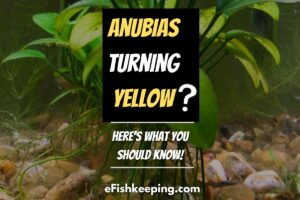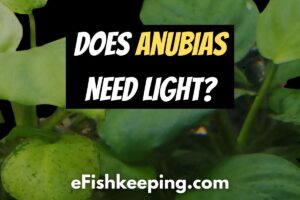If you have a freshwater planted aquarium with Amazon Swords, they provide the best-looking foliage. Their bright green leaves not only give your fish wonderful hiding spaces, but they also help cover filters and other pumps. But, you may notice that the leaves are turning yellow.
There are several possible reasons why your Amazon Sword is turning yellow. Lack of iron, nitrogen, and/or potassium will almost always be the culprit. But, it could be something like poor tank conditions, incorrect pruning, inadequate substrate, and overcrowding, among others.
Much of what happens with yellowing in an Amazon Sword is a lack in providing conditions similar to its native habitat. So, because you can find them naturally from the US down to Argentina, it’s a good idea to study that general environment. Typically, it’s going to need warm water, bright light, and nutrient-rich soil.
Causes for Amazon Sword Yellowing
#1. Lack of Fertilizer
The most common cause of yellowing is a lack of fertilizer and nutrients. This happens due to how the water can rob the plant of its ability to absorb nutrients. What compounds this is the fact that Amazon Swords are heavy root feeders.
#2. It’s a New Addition
If the yellowing Amazon Sword is new to your tank, it gives an appearance as if it’s melting or dying away. This is a common and typical event until the plant adjusts to its new home.
#3. Poor Tank Conditions
Whenever you see a yellowing Amazon Sword plant, you want to make sure the water parameters are just right.
So, do a test and make sure the pH balance sits between 6.5 and 7.5 with a temperature range of 72°F and 82°F (22°C to 27°C). The hardness of the water, or dHK, should read somewhere between 8° and 15°.
#4. Pruning Issues
There are times when the plant simply needs some trimming of dead growth, or the yellow is appearing because of incorrect pruning you recently did.
Note that new leaves start as thin light green and become a thick dark green as they mature. Once spent, the leaves turn yellow and require a trim. So, you should already be in the process and habit of trimming and pruning.
But, If you trim off too much foliage, not enough dead leaves, or disturb the roots (including uprooting), the Amazon Sword will begin to yellow and die. The right amount of pruning will be necessary in order to ensure the plant stays healthy and thriving.
#5. Too Much or Not Enough Light
Amazon Swords require about two to three watts of light per gallon. This translates to about 10 to 12 hours of bright light each day, which is quite a bit. However, if you expose the plant to too much light, it will succumb to algae growth.
While Amazon Swords can thrive well under lower lighting, it will force them to grow much slower. Because of the energy mismatching the rate of growth, yellowish leaves and stems can appear.
#6. Inadequate Substrate
There should be a substrate on the bottom of the tank that’s not only iron-rich but also nourishing, soft, and flexible enough to hold down the roots and root tabs. Gravel and large rocks are not ideal substrates.
#7. Overcrowding; Lack of Space
If you have a well-stocked tank or your Amazon Sword plants proliferate profusely throughout your aquarium, they aren’t getting enough oxygen and water flow. The sensation of choking brings about a yellowish-brown color in the leaves.
#8. Pests; Diseases
Amazon Sword plants are fairly hardy that are quite immune to most pests and diseases. However, three main problems can force the leaves to turn yellow: excess algae, aphids, and root rot.
Excess Algae
Because of the high light requirement, excess algae growth can become a problem for your delicate mini-ecosystem. This will attach to the leaves of an Amazon Sword and give it a yellowed or browning appearance.
Aphids
Aphids are insects that infect plants on land and in water. Amazon Swords are not immune to them. Since there is plenty of food for the plants, aphids won’t be far behind.
Root Rot
If you know anything about regular gardening, root rot is a serious issue that can affect any plant because it receives too much water.
With an Amazon Sword, it’s already in the water, so root rot occurs as a result of the root’s exposure to water without enough covering substrate.
These will make the roots turn horrid brownish-black, and the leaves will turn yellow and translucent.
Potential Cures:
#1. Lack of Fertilizer
Use root tabs when you install the plant into the tank.
If root tabs are already in place and you recently did some water changes, then it’s time to replace them.
Otherwise, you can get an iron-rich target fertilizer or pellet. Expect to add new fertilizer at least once per month.
· Age Matters for Fertilizer:
Determine the Amazon Sword’s age to ensure you provide the right kind of nutrients. While yellowing is a sign of a nutrient deficiency, regardless of the plant’s age, younger plants require more iron.
Older and more mature plants will need more nitrogen and potassium.
· Wrinkling or Holes:
If there’s wrinkling or holes in the leaves, it’s a sure sign of a potassium deficiency. There are many liquid and target fertilizers for this.
The Amazon Sword will absorb it immediately without affecting the tank’s water parameters. Just ensure you offer fertilizer as close to the roots as possible.
Potassium is one of the crucial elements in maintaining the growth level in planted aquariums. If you have a fast-growing system or if the water lacks mineral content then potassium can become depleted and can be a restricting factor for the ideal growth. However, by using the Flourish Potassium, you can prevent the potassium depletion.
Seachem Flourish Potassium

Get This Here (on Amazon)
#2. It’s a New Addition
If the plant is adjusting to its new home, trim away the dead growth. As long as the water parameters are perfect, it will recover as if nothing ever happened.
#3. Dying Foliage that Needs Pruning
If the yellow is only on a few leaves and stems, gently trim them away. But you want to do this as close to the base so that the greenest parts expose in the water. This is because Amazon Swords have stubby rhizomes with short stems and long leaves.
On average, figure you’ll cut off the top two inches once you see yellowing growth. The right amount of pruning will be necessary in order to ensure the plant stays healthy and thriving.
It’s best to trim and prune immediately after a water change.
When it comes to taking care of aquarium plants, you will often have to use the aquascaping tools. Here I recommend this 5 in 1 aquascaping tool set that will take care of all aquarium plants, along with cleaning fish tank substrate and aquarium gravel.
capetsma Aquascape Tools

Get This Here (on Amazon)
#4. Too Much or Not Enough Light
Make sure the Amazon Sword receives 10 to 12 hours of light every day and that it’s somewhere between moderate to heavy in strength.
#5. Inadequate Substrate
Things like sand, mud, and pebbles are the most ideal substrate for Amazon Swords. However, if you want to weigh down the roots to ensure they stay covered and secured by the substrate, then a few rocks and gravel can’t hurt. But, it shouldn’t be the sole makeup of the substrate for the plant.
#6. Overcrowding; Lack of Space
If the tank lacks space, you’ll have to reduce the plants or remove decorations to ensure breathing room.
Since Amazon Swords can reach up to 20 inches in height with a max width of 12 inches, it’s easy for them to take over.
#7. Pests; Diseases
If excess algae, aphids, or root rot are an issue, consider the treatments below:
· Excess Algae:
You can trim off any leaves laden with algae and have critters that love to eat algae like snails, shrimp, or catfish.
· Aphids:
Having fish and other creatures that like to eat insects, such as Bettas, will be ideal for keeping aphids under control.
However, if the problem is bad, you will have to trim them off. But, you won’t be able to use an insecticide. So, you may need to quarantine the plants.
· Root Rot:
Ensure you bury the roots deep within the substrate while taking care not to bury the crown or parts usually situated above the substrate. Burying the plant too deeply can also create root rot.
Final Thoughts
Amazon Swords are an excellent addition to a freshwater aquascape. It provides a beautiful, green, and lush environment great for fish. But, when you see yellowing foliage, you have to take care of the problem quickly.
Always evaluate the water parameters to ensure they checkout and then look at the plant for pests, root rot, and lack of nutrients. These are heavy feeders, so Amazon words must have equal amounts of iron, potassium, and nitrogen.
Recommended Reading:
Hi! I’m Praveen Ghoshal, the founder of eFishkeeping.com. Inspired by my Dad, I got interested in fishkeeping when I was a kid. Since then, I have been involved with this hobby. Currently, I have 3 fish tanks at our home, and I enjoy this hobby with my full family. Read more about me here.






![Anubias Has Holes In Leaves? [Top 5 Causes And Solutions] anubias-has-holes-in-leaves](https://efishkeeping.com/wp-content/uploads/2023/04/anubias-has-holes-in-leaves-300x202.jpg)
